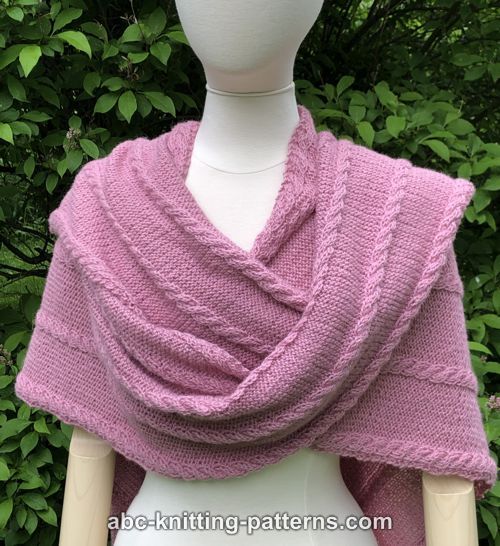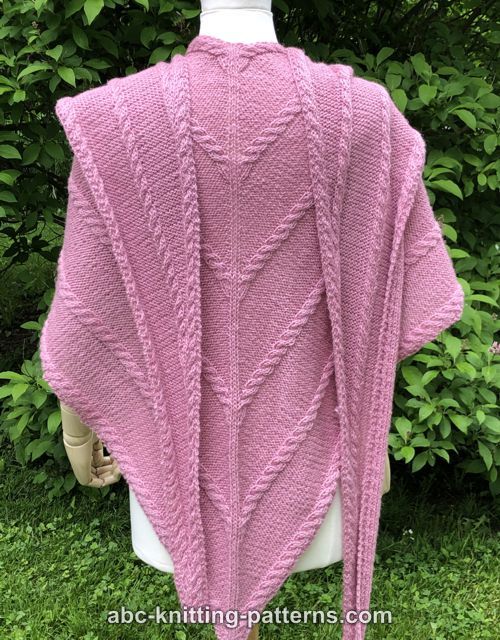



 Easy
EasyFree Shawl Knitting Pattern
Wrap yourself in the gentle embrace of spring with the Blossoming Vines Cable Shawl—a triangular shawl that blooms with intricate, intertwining cable vines reminiscent of lilac branches in full flower. The rhythmic play of cables creates elegant movement across the fabric.
Perfect for intermediate knitters seeking a meditative yet rewarding project, this shawl pairs beautifully with worsted weight yarn and invites endless color possibilities. Drape it over your shoulders for a touch of handmade elegance, or gift it as a cherished heirloom—either way, the Blossoming Vines Cable Shawl is a timeless celebration of texture, color, and craft.
Skills Required/Techniques Used:
-Knit & purl, cast on & bind off
-Increasing :yarn over (YO),
-Decreasing: purl 2 tog (p2tog)
-Working simple cable
Size: wings span 90” (225 cm), height 30” (75 cm)
Materials: 100% worsted weight wool, 220 yards (201 meters) / 100 gr, color beige – 5 skeins
Notions: stitch markers, spare pair of circular needles or a piece of waste yarn to hold stitches, yarn/tapestry needle.
Needles: US 6 (4.0 mm) circular needles OR SIZE NEEDED TO OBTAIN GAUGE
Gauge: 18 sts x 24 rows = 4" x 4" (10cm x 10cm) In stockinette st:
Pattern Notes
Abbreviations
plm – place marker
slm – slip marker
rm – remove marker
k – knit
p – purl
k2tog – knit 2 together, 1 stitch decreased.
p2tog – purl 2 together, 1 stitch decreased.
m 1 (Make 1 increase) - Make a backward loop over the right-hand needle.
2/2 LC - 2x2 cable with left cross: Slip next 2 stitches to cable needle and place at front of work, k2, then k2 from cable needle.
2/2 RC - 2x2 cable with right cross: Slip next 2 stitches to cable needle and place at back of work, k2, then k2 from cable needle.
1/1 LC - 1x1 cable with left cross: Slip next stitch to cable needle and place at front of work, k1, then k1 from cable needle.
1/1RC - 1x1 cable with right cross: Slip next stitch to cable needle and place at back of work, k1, then k1 from cable needle.
RS - right side
WS – wrong side
Double Garter Selvedge
Consists of 2 sts, knit 2 sts at the beginning of the row and knit 2 sts at the end of the row in every row.
Short Overview of the pattern
The shawl is worked from the bottom up in 2/2 cables and 12 sts of the reverse stockinette st between them. The shawl construction allows to knit the shawl of any size. The shawl begins from 6st-cast-on. The increases are made in every RS row on both sides of the central stitches, which are marked with 2 stitch markers. The increased stitches are then included in either cables or reverse stockinette stitch. After the central part of the shawl reaches the required size it has a square shape placed on point. Then the wings of the shawl are worked separately, one wing at a time.
Two stitches are added to the central stitches by knitting m1 before and after the central sts. All the stitches are divided in half, on both sides of these 4 central stitches. Two right central stitches become the selvedge stitches of the rwing, another 2 left central stitches become the selvedge stitches of the left wing.
The wings are shaped with the decreases, which are worked at the inner side of each wing. The decreases (p2tog) are worked in RS rows, every 4th row, immediately after the 2/2 cable for the left wing and before the last 2/2 cable for the right wing. The rest of the wing is worked as established. Each wing is worked this way until there are 8 sts left. Then the stitches are bound off.
Shawl
Cast on 6 sts.
Row 1 (RS): (K2, plm) × 2, k2. (6 sts)
Row 2 (WS): K2, slm, p2, slm, k2.
Row 3 (increase row): K2, m1, slm, k2, slm, m1, k2. (8 sts)
Row 4: K2, p1, slm, p2, slm, p1, k2.
Row 5 (increase row): K3, m1, slm, k2, slm, m1, k3. (10 sts)
Row 6: K2, (p2, slm) × 2, p2, k2.
Row 7: K2, 1/1 RC, m1, slm, k2, slm, m1, 1/1 LC, k2. (12 sts)
Row 8: K2, p3, slm, p2, slm, p3, k2.
Row 9: K5, m1, slm, k2, slm, m1, k5. (14 sts)
Row 10: K2, p4, slm, p2, slm, p4, k2.
Row 11: K2, 2/2 RC, m1, slm, k2, slm, m1, 2/2 LC, k2. (16 sts)
Row 12: K2, p4, k1, slm, p2, slm, k1, p4, k2.
Row 13: K6, p1, m1, slm, k2, slm, m1, p1, k6. (18 sts)
Row 14: K2, p4, k2, slm, p2, slm, k2, p4, k2.
Row 15: K2, 2/2 RC, p2, m1, slm, k2, slm, m1, p2, 2/2 LC, k2. (20 sts)
Row 16: K2, p4, k3, slm, p2, slm, k3, p4, k2.
Row 17: K6, p3, m1, slm, k2, slm, m1, p3, k6. (22 sts)
Row 18: K2, p4, k4, slm, p2, slm, k4, p4, k2.
Row 19: K2, 2/2 RC, p4, m1, slm, k2, slm, m1, p4, 2/2 LC, k2. (24 sts)
Row 20: K2, p4, k5, slm, p2, slm, k5, p4, k2.
Row 21: K6, p5, m1, slm, k2, slm, m1, p5, k6. (26 sts)
Row 22: K2, p4, k6, slm, p2, slm, k6, p4, k2.
Row 23: K2, 2/2 RC, p6, m1, slm, k2, slm, m1, p6, 2/2 LC, k2. (28 sts)
Row 24: K2, p4, k7, slm, p2, slm, k7, p4, k2.
Row 25: K6, p7, m1, slm, k2, slm, m1, p7, k6. (30 sts)
Row 26: K2, p4, k8, slm, p2, slm, k8, p4, k2.
Row 27: K2, 2/2 RC, p8, m1, slm, k2, slm, m1, p8, 2/2 LC, k2. (32 sts)
Row 28: K2, p4, k9, slm, p2, slm, k9, p4, k2.
Row 29: K6, p9, m1, slm, k2, slm, m1, p9, k6. (34 sts)
Row 30: K2, p4, k10, slm, p2, slm, k10, p4, k2.
Row 31: K2, 2/2 RC, p10, m1, slm, k2, slm, m1, p10, 2/2 LC, k2. (36 sts)
Row 32: K2, p4, k11, slm, p2, slm, k11, p4, k2.
Row 33: K6, p11, m1, slm, k2, slm, m1, p11, k6. (38 sts)
Row 34: K2, p4, k12, slm, p2, slm, k12, p4, k2.
Row 35: K2, 2/2 RC, p12, plm, m1, slm, k2, slm, m1, plm, p12, 2/2 LC, k2. (40 sts)
Row 36: K2, p4, k12, slm, p1, slm, p2, slm, p1, slm, k12, p4, k2.
Row 37: work as est., slm, k1, m1, slm, k2, slm, m1, k1, slm, work as est. (42 sts)
Row 38: work as est., (slm, p2) × 3, slm, work as est.
Row 39: work as est., slm, 1/1 RC, m1, slm, k2, slm, m1, 1/1 LC, slm, work as est. (44 sts)
Row 40: work as est., slm, p3, slm, p2, slm, p3, slm, work as est.
Row 41: work as est., slm, k3, m1, slm, k2, slm, m1, k3, slm, work as est. (46 sts)
Row 42: work as est., slm, p4, slm, p2, slm, p4, slm, work as est.
Row 43: work as est., slm, 2/2 RC, m1, slm, k2, slm, m1, 2/2 LC, slm, work as est. (48 sts)
Row 44: work as est., slm, p4, k1, slm, p2, slm, k1, p4, slm, work as est.
Row 45: work as est., slm, k4, p1, m1, slm, k2, slm, m1, p1, k4, slm, work as est.. (50 sts)
Row 46: work as est., slm, p4, k2, slm, p2, slm, k2, p4, slm, work as est.
Row 47: work as est., slm, 2/2 RC, p2, m1, slm, k2, slm, m1, p2, 2/2 LC, slm, work as est. (52 sts)
Row 48: work as est., slm, p4, k3, slm, p2, slm, k3, p4, slm, work as est.
Row 49: work as est., slm, k4, p3, m1, slm, k2, slm, m1, p3, k4, slm, work as est. (54 sts)
Row 50: work as est., slm, p4, k4, slm, p2, slm, k4, p4, slm, work as est.
Row 51: work as est., slm, 2/2 RC, p4, m1, slm, k2, slm, m1, p4, 2/2 LC, slm, work as est. (56 sts)
Row 52: work as est., slm, p4, k5, slm, p2, slm, k5, p4, slm, work as est.
Row 53: work as est., slm, k4, p5, m1, slm, k2, slm, m1, p5, k4, slm, work as est. (58 sts)
Row 54: work as est., slm, p4, k6, slm, p2, slm, k6, p4, slm, work as est.
Row 55: work as est., slm, 2/2 RC, p6, m1, slm, k2, slm, m1, p6, 2/2 LC, slm, work as est. (60 sts)
Row 56: work as est., slm, p4, k7, slm, p2, slm, k7, p4, slm, work as est.
Row 57: work as est., slm, k4, p7, m1, slm, k2, slm, m1, p7, k4, slm, work as est. (62 sts)
Row 58: work as est., slm, p4, k8, slm, p2, slm, k8, p4, slm, work as est.
Row 59: work as est., slm, 2/2 RC, p8, m1, slm, k2, slm, m1, p8, 2/2 LC, slm, work as est. (64 sts)
Row 60: work as est., slm, p4, k9, slm, p2, slm, k9, p4, slm, work as est.
Row 61: work as est., slm, k4, p9, m1, slm, k2, slm, m1, p9, k4, slm, work as est. (66 sts)
Row 62: work as est., slm, p4, k10, slm, p2, slm, k10, p4, slm, work as est.
Row 63: work as est., slm, 2/2 RC, p10, m1, slm, k2, slm, m1, p10, 2/2 LC, slm, work as est. (68 sts)
Row 64: work as est., slm, p4, k11, slm, p2, slm, k11, p4, slm, work as est.
Row 65: work as est., slm, k4, p11, m1, slm, k2, slm, m1, p11, k4, slm, work as est. (70 sts)
Row 66: work as est., sm, p4, k12, slm, p2, slm, k12, p4, work as est.
Row 67: work as est., 2/2 RC, p12, plm, m1, slm, k2, slm, m1, plm, p12, 2/2 LC, work as est. (72 sts)
Row 68: work as est., p4, k12, slm, p1, slm, p2, slm, p1, slm, k12, p4, work as est.
Repeat rows 37-68 three more times or to desired size.
Repeat rows 37-44 one more time. While repeating row 43, work (m1, k 2, m1) between 2 central markers, increasing the center sts from 2 to 4.
Left Wing
Next RS row work as established.
Next WS row work only half of the stitches as est., stopping after the first 2 central stitches (these sts are now selvedge sts). Transfer remaining stitches to another circular needle or to a length of waste yarn.
Next RS row: k2, 2/2 LC, p2tog, continue as established. This is the first decrease. The decreases are made with the 2 sts after the 1st 2/2 cable. The decreases are made in each alternating RS row (every 4th row).
Continue to work the shawl as est, working a decrease in every other RS row until there is 8 sts left. Bind off.
Right Wing
Transfer stitches from waste yarn to the circular needles. Secure the yarn at the 1st stitch of the remaining shawl sts. Work WS row as established.
Next RS row: work as established to the last 8 sts, p2tog, 2/2 RC, k2. This is the first decrease. The decreases are made with the 2 sts before the last 2/2 cable. The decreases are made in each alternating RS row (every 4th row).
Continue to work the part as est, working a decrease in every other RS row until there is 8 sts left. Bind off.
Finishing:
Weave in all yarn ends. Block.
Have fun!





